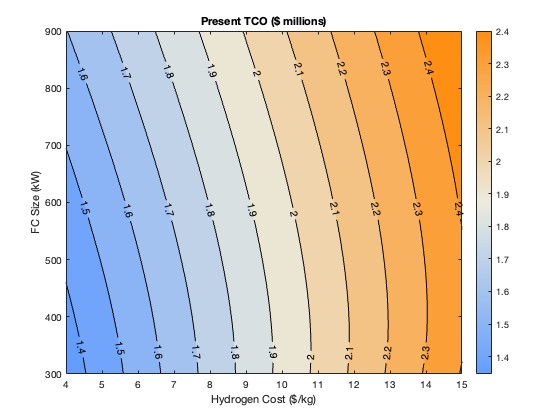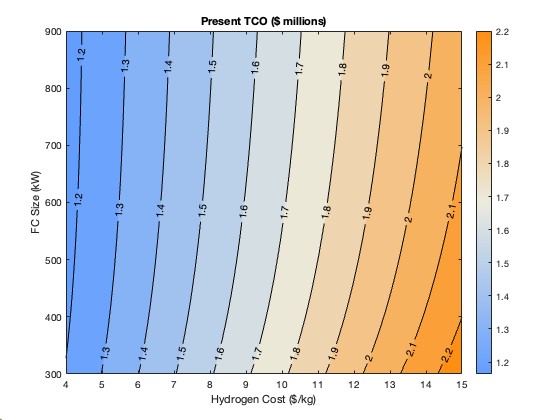

In this insight article, we explore how different fuel cell sizes, combined with varying hydrogen prices, can significantly impact the economic feasibility of heavy-duty trucks. We will explore a case study that demonstrates the potential advantages of a smaller fuel cell, analyze why this problem remains open-ended, and consider the risks and other factors that fleet operators must consider when making these decisions.

As the world accelerates its transition to a decarbonized economy, low carbon hydrogen is among the most popular solutions being pursued by technologists and investors alike, particularly in the context of long-haul trucking. While emissions benefits are clear, the answer to whether hydrogen fuel cell technology is adopted at-scale ultimately rests with cost. The cost of not just hydrogen itself, but also that of the powertrain design and operational requirements of vehicle fleets.
Namely, fuel cell sizing has immense influence on both the initial fleet investment and long-term operating costs. The decision to opt for a larger or smaller fuel cell isn’t straightforward; it requires a careful consideration and balance between capital expenditure (CAPEX) and operational expenditure (OPEX). Larger fuel cells, while commanding a larger capital outlay upfront, offer greater efficiency and durability, leading to lower ongoing costs. Conversely, smaller fuel cells, though more affordable initially, can result in higher operational expenses due to more frequent refueling and maintenance needs. This trade-off makes fuel cell sizing a critical factor in optimizing the total cost of ownership (TCO) for fleet operators.
In this insight article, we explore how different fuel cell sizes, combined with varying hydrogen prices, can significantly impact the economic feasibility of heavy-duty trucks. We will explore a case study that demonstrates the potential advantages of a smaller fuel cell, analyze why this problem remains open-ended, and consider the risks and other factors that fleet operators must consider when making these decisions.
To illustrate the impact of fuel cell sizing on TCO, Sesame was used to model a fuel cell electric truck with hybrid powertrain architecture. Here the modeled TCO captures CAPEX and OPEX costs over a ten-year asset lifetime. Model parameters are consistent with a class 8 tractor-trailer operating over a long-haul duty cycle. Figure 1 shows how TCO varies as a function of both fuel cell size and delivered hydrogen cost. Here the contour lines all slant diagonally to the left, indicating that TCO increases as both hydrogen cost and fuel cell size increase. As hydrogen cost increase (moving right along the contour plot), the contours become more vertical. This is indicative of increasing fuel efficiency, and thus fuel savings, offered by larger fuel cell architectures.

Figure 1: TCO contour lines considering present day costs and technology. The variables considered are hydrogen cost and the fuel cell size. In this scenario, small fuel cells are optimal.
The takeaway from the case study is obvious: small fuel cells win! But do they always win? The results of any TCO analysis are dependent on the model data and their relative influence on model output. In the case of a fuel cell truck, there are many model parameters whose sensitivities can significantly affect the conclusions drawn from the TCO output. To illustrate this, let’s look at the results when we reduce the price density ($/kW) of the fuel cell. Figure 2 shows the opposite results of the case previously shown, and all we did was change one parameter!

Figure 2: TCO contour lines when the fuel cell price density is lowered. By changing one parameter the analysis relative to the case study is flipped, and larger fuel cells are preferred.
Fuel cell price density is not the only input parameter in the complex topic of fuel cell sizing to reduce TCO. A few other fuel cell parameters that can single handedly change the analysis are duty cycle, durability, weight, efficiency, fuel economy, power density, fuel costs, refueling times, interest from debt, and maintenance and repair costs. This is by no means an exhaustive list of parameters, and the list can become exponentially larger as a model becomes more complex.
What does this mean? There is no one size fits all solution. Each use case requires a tailored scenario analysis. Citing publications, reports, or social media posts (like this one) that analyze a single set of parameters is not sufficient. Fortunately, Sesame offers a data-rich and centralized modeling platform that enables true apples-to-apples comparisons of technologies. This allows users to perform the scenario analysis that best suits their needs, helping their companies minimize cost uncertainty when planning a portfolio of assets.
While the analysis provides valuable insights into the trade-offs involved in fuel cell sizing for heavy-duty trucks, it also highlights the complexity and uncertainty inherent in the decision-making process. The balance between CAPEX and OPEX is influenced by a myriad of factors, many of which are subject to change due to technological advancements, regulatory shifts, and market dynamics. This ongoing need for evaluation and adjustment underscores the importance of expertise and advanced tools—such as those offered by Sesame Sustainability.
Sesame Sustainability provides a comprehensive, all-in-one platform that empowers fleet operators and energy companies to assess the full impact of value chain choices. By enabling advanced scenario analysis and centralizing data, Sesame helps users optimize key variables like CAPEX, OPEX, and total cost of ownership (TCO) and make informed decisions that minimize uncertainty and ensure both economic feasibility and long-term sustainability.
As hydrogen technology and market dynamics evolve, Sesame Sustainability’s platform allows companies to stay agile and continuously adapt to new information. By leveraging Sesame’s cutting-edge tools, businesses can position themselves for success in an ever-changing energy landscape.
Stay tuned for the emission impact side of the story!
Dr. Rob Jones is an experienced business development and strategy leader with a strong background in chemical engineering and sustainability. He holds an MBA from MIT Sloan School of Management and a PhD in Chemical Engineering from MIT. Rob has worked across various sectors, including clean energy, venture capital, and software development, where he has applied his expertise in business strategy, market analysis, and technology assessment.